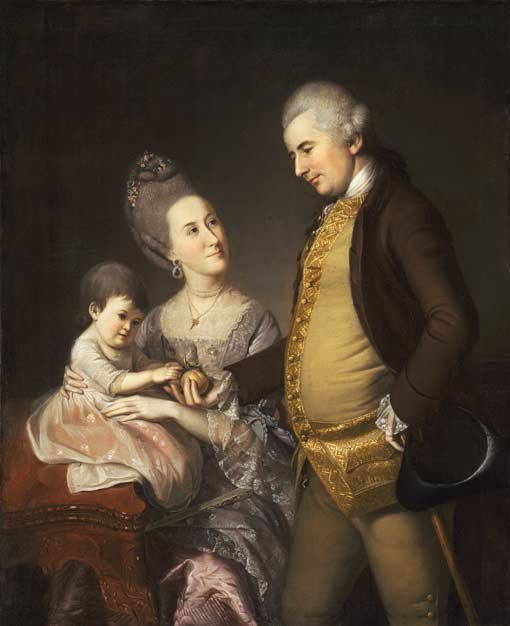Towards an American aesthetic

Focus work
Charles Willson Peale
Portrait of John and Elizabeth Lloyd Cadwalader and their daughter Anne 1772
Philadelphia Museum of Art, purchased for the Cadwalader Collection with funds contributed by the Mabel Pew Myrin Trust and the gift of an anonymous donor 1983
Issues for discussion
In the 18th century having a portrait painted was considered an expression of social or familial pride. How does this portrait capture this ideal? Describe the relationship between the figures in this painting. How does their pose suggest a more informal approach compared to traditional portrait painting? Discuss how this could be a reflection of the ‘new’ America.
Artist biography
Charles Willson Peale initially worked as a saddler in Annapolis, Maryland, but in 1766 an elite group of patrons sponsored him to study in London under renowned painter Benjamin West. This venture allowed Peale to study neoclassical portrait painting, visit the studios of portrait painters and receive technical training in miniature painting and engraving. He also received his first portrait commission. On his return to Annapolis, Peale established a steady practice and introduced American clients to a sophisticated British aesthetic. In 1772 he produced the first portrait of George Washington and would produce six more. In 1776 Peale moved permanently to Philadelphia where he began his engagement with politics and joined the Pennsylvania militia; his political views polarised his clients and his business deteriorated as a result. In 1782 Peale opened a portrait gallery which in 1786 he expanded and named Peale’s Museum (it later became the Philadelphia Museum). With his obligations at the museum Peale’s practice decreased, although he did return to engraving and produced mezzotints of his portraits. It wasn’t until he retired in 1810 that he began painting again, continuing with portraiture and expanding into landscapes. Peale’s experiments and innovations laid foundations that many later artists would build on. He introduced a lively humanity into the family portrait, allegorical embellishments into official portraiture and bravura trompe l’oeil effects. Five of Peale’s 11 children – Franklin, Raphaelle, Rembrandt, Rubens and Titian Ramsey – became prominent artists.
More information
Philadelphia Museum of Art website, including audio